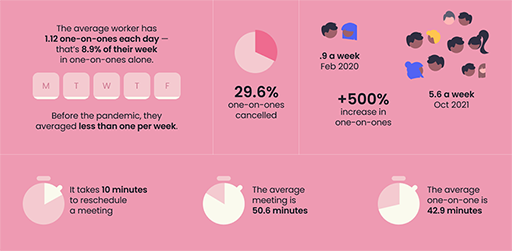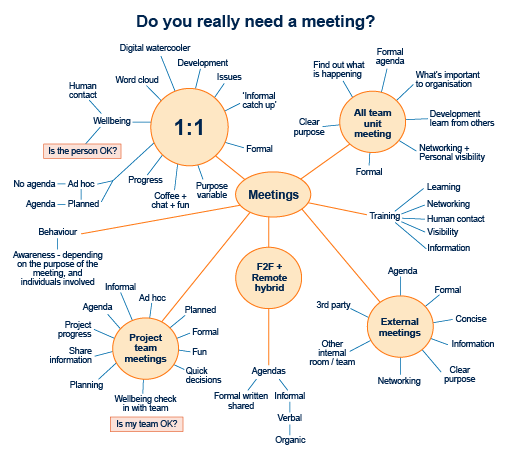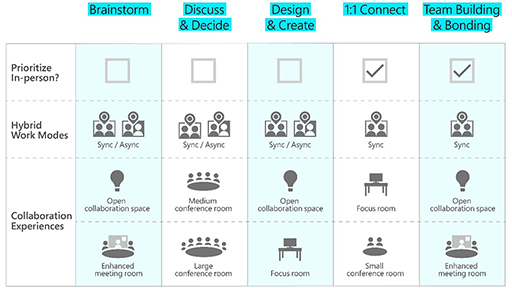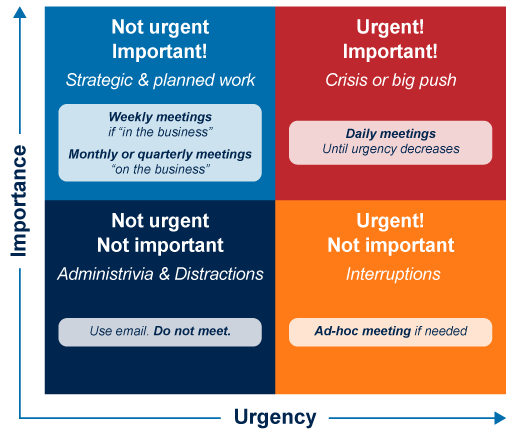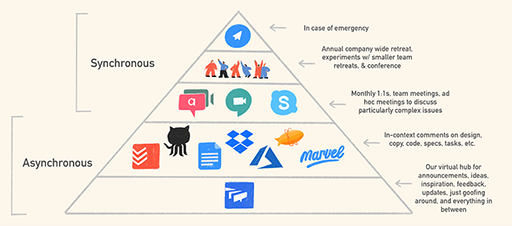7 Do you really need a meeting?
We are spending more time in meetings, and the first question you need to ask is: ‘Why do you need a meeting?’ Is another communication channel better or more effective? The image and table below, based on the ‘Productivity trends report: one-on-one meeting statistics’ by reclaimai (2021), provide a useful visual overview of just how much of our working life is taken up by meetings.
| Activity | Average Professional | Busy Professional |
|---|---|---|
| Meetings per week | 21.5 hours | 39.9 hours |
| One-on-ones rescheduled a year | 118.7 | 182.3 |
| One-on-ones cancelled per year | 82.9 | 127.3 |
| 1:1 a year Feb 2020 | 45 | 100 |
| 1:1 a year Oct 2021 | 278 | 430 |
| Workday Feb 2020 | 7.5 hours | 9.0 hours |
| Workday Oct 2021 | 8.9 hours | 10.13 hours |
Source: reclaimai (2021)
Activity 23 How much time do you spend in meetings?
Have a look at ‘Productivity trends report: one-on-one meeting statistics’ [Tip: hold Ctrl and click a link to open it in a new tab. (Hide tip)] (reclaimai, 2021) and think about the meetings you have. Spend some time defining what type of meetings you have (Who are they with? What are they for?), and decide which are essential.
Are there other ways of gathering the information you require instead of from a meeting? What is the value of the meeting for you, for your role or for your wellbeing?
Feedback
I spend most of my time in meetings, and they have different purposes. The image below shows my four main groups of meetings, and these can vary from being face to face, completely virtual or hybrid. While most of the meetings have a formal business purpose, some are for informal catch-ups or because I need to ask questions to understand something I am working on.
The most important thing for me, though, is the wellbeing of those I work with and my own wellbeing. Meetings are also opportunities for human connections, which is important for those who are working remotely.
What’s the purpose of the meeting?
Being clear on the purpose of the meeting, what type of meeting it needs to be – in person, hybrid or remote – and how it will be run will lead to more effective and valuable meetings.
How confident and curious you are, and your preferred way of working, will often be reflected in your choice of meeting type. I am comfortable attending any type of meeting and don’t really distinguish between them, as for me it is just a meeting, and my approach and behaviour will focus on the purpose of the meeting rather than how the meeting is being held.
For others, different meeting types can be challenging, and some people may find that their confidence is a little lower now, especially if they are new to the organisation or in their first job. In addition, expectations for attending meetings are now different, and workplace ‘norms’ are not necessarily as transparent when working in hybrid ways as when everyone was working in the office.
Wellbeing is also an important consideration when deciding if a meeting is really needed. During the pandemic, especially in periods of lockdowns, meetings often helped to reduce the feelings of isolation and loneliness. However, as restrictions have lifted, our lives have become busier, and the need for meetings for human interaction is potentially reducing. Meetings can impact productivity and can lead to employees having to ‘catch up’ with day-to-day work at the end of the day. People may experience ‘meeting fatigue’, which we explored in the Hybrid working: wellbeing and inclusion course.
Type of meeting
The table below captures some of the different types of meetings you might participate in. You may want to reflect on the activity earlier in the course about what type of meetings you attend. You will note for most that you can take any approach, as the best choice will depend on the purpose and those involved.
| In person only | Hybrid | Remote |
|---|---|---|
| Regular 1:1 check ins | Regular 1:1 check ins | |
| Complicated and/or sensitive conversations | Complicated and/or sensitive conversations | |
| Regular team meetings | Regular team meetings | Regular team meetings |
| Project progress meetings | Project progress meetings | Project progress meetings |
| Planning meetings | Planning meetings | Planning meetings |
| Presentations to large numbers of people | Presentations to large numbers of people | |
| Unit/All company updates | Unit/All company updates | |
| Longer meetings, such as committee meetings | Longer meetings, such as committee meetings | |
| Workshops, design and problem-solving sessions | Workshops, design and problem-solving sessions | Workshops, design and problem-solving sessions |
| Training and development | Training and development | |
| Third-party clients/suppliers | Third-party clients/suppliers | Third-party clients/suppliers |
Microsoft (n.d.a) suggests there are five types of hybrid meeting. Considering which work mode and collaboration experience you need, as shown in the figure below, can help you decide which approach to meetings to take.
Activity 24 How often do you need a meeting?
Having considered the types of meetings you arrange/attend, think about the frequency of these.
Read the following article, ‘How to find the most productive meeting schedule for a team like yours’ (Keith, 2020), and use the figure below to think about the frequency of meetings you arrange or attend.
Once you have considered the purpose of meetings, you can establish if you actually require a meeting or if you need to work on a specific task. There may be an asynchronous solution to solve it, or you may need arrange a ‘working’ session using other digital tools.
In the collaboration section we explored different ways to collaborate. Often when I meet with others, either in person or virtually, it is to work on something. We may use a variety of tools to achieve the desired outcome synchronously (in live time). These are not meetings but focused activities where, rather than talking about what needs to be done, we do something. Often, we don’t even have to talk to each other: we use the tools available to us to contribute and share information asynchronously (not in live time) to progress the outcomes required.
Activity 25 What is your alternative to a meeting?
HEIs are becoming more ‘digital’ and may be looking to use non-traditional tools. This article by doist, a remote organisation, provides insight into alternative ways of communication and collaboration and breaks down how they use tools in the figure below: ‘The pyramid of remote team communication tools’ (doist, n.d.)
Think about the outcomes you often want to achieve through a meeting or actions that are required and how you else might approach this. The articles below may give you some ideas to consider. Then list approaches you can easily implement and those that may require wider engagement with others – think about the team working agreement.
- ‘What happened when we stopped having meetings and sending emails | Government Digital Service’ (GOV.UK, 2020)
- ‘How to transform your culture? Have two days with no meetings’ (Make Work Better, 2022)
- ‘Stop having meetings. Start having conversations’ (Berry, 2022)
- ‘How to stop having “too many meetings” by building an asynchronous culture’ (Kergaravat, 2021)

